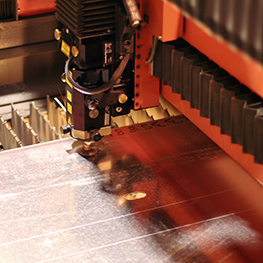Recently, I had a conversation with one of our great long time manufacturing customers in the metal products space. This manufacturer has been in business for nearly 100 years, and they pride themselves on a commitment to advanced engineering and manufacturing the impossible with metal. The operations and inventory employees at this metal products manufacturer are looking to become more efficient and specifically to improve traceability of work orders to the outputs of their machines. As a trusted advisor and partner to their manufacturing business they asked if we could help. The answer is yes we can simplify your manufacturing through our integration with machine nesting interface software.
Producing the Product
A nest is a group of work orders that require the same material (in this case sheeted metal) to make a certain part. Nesting software automatically and simply arranges the required quantities of individual parts on sheets or plates of material.
For example, imagine you need to cut hundreds of flat brackets from a single sheet of metal for several work orders from different customers. The finished brackets all come from the single sheet with remnant material left over. How do you attribute cost if one work order is 10 parts and another is 15 and another is 22, and so on?
Since the work orders are from different customers and since you are not physically issuing each small piece of metal needed for the part (again, you are using one single sheet to created hundreds of parts versus hundreds of sheets) you have to issue the entire sheet to all work orders. The machine nesting software can tell you how much of that sheet was used for each work order in most cases. Word to the wise, some nesting software cannot report exact job material relationships, so you should do your due diligence before selecting one.
Making it Simple
Most of the integrations created between Global Shop Solutions ERP software and machine nesting software for its customers are seamless and work in the background. So it is vitally important that the accuracy of the data going in is critical to accurate data coming out.
Generally, Global Shop Solutions ERP software will export job requirements to the machine nesting software, which will then feedback to Global Shop Solutions ERP software what is needed per job and the drop parts that need to be created for remnant material. For example, I used 16×60 from a sheet of metal to make a variety of parts from a 48×96 sheet of metal, so the remnant is 32×36. Additionally, the machine nesting software reports back the nesting labor time for the job detail to Global Shop Solutions ERP software.
Seeing Multiple Benefits
Combining your Global Shop Solutions ERP software with machine nesting software provides many benefits typically best realized in your costing, operations, and inventory control. This integration provides traceability back to your work orders so your nested work orders can have more accurate costs applied instead of an average cost for the entire nest, which in some cased can be totally misleading. Additionally, remnant pieces can be tied to specific lot/heat material identifiers leading to better inventory and costing for sheeted material.
Every day our manufacturing customers are faced with stiffer competition from around the world. We are happy to be in a position to help them simplify their manufacturing and quite frankly, we do it better than anyone else in the market. Want proof? We have more case studies publicly available than any other manufacturing software company in the world – 150+ customers are willing to put their names next to ours. I invite you to read any or all of them and also come visit our global headquarters in The Woodlands, TX.
Push the Sled blog is written by Dusty Alexander, CEO of Global Shop Solutions, because no matter how good you get (at physical fitness, running a manufacturing business or being an ERP user) you can always work harder, get better, and be humble.


 USA
USA
 United States
United States Indonesia
Indonesia Mexico
Mexico Australia
Australia United Kingdom
United Kingdom New Zealand
New Zealand Singapore
Singapore